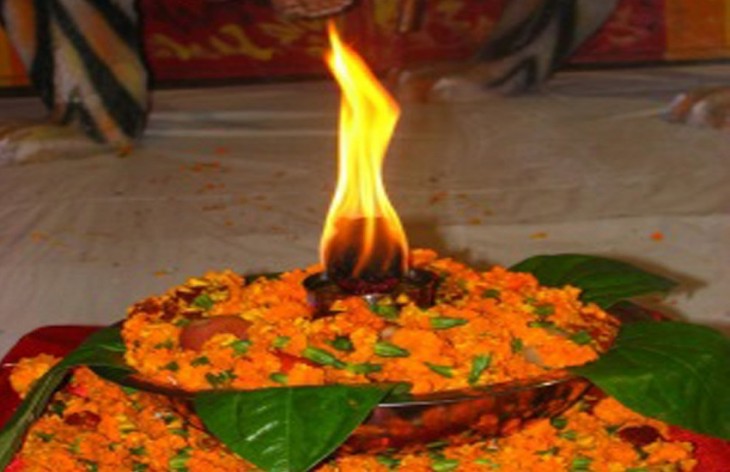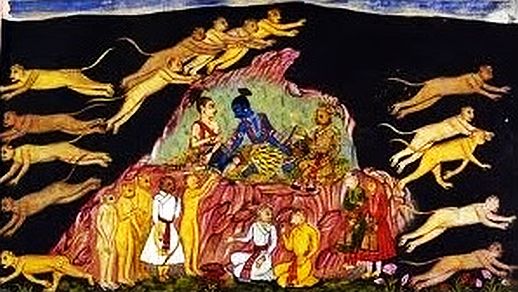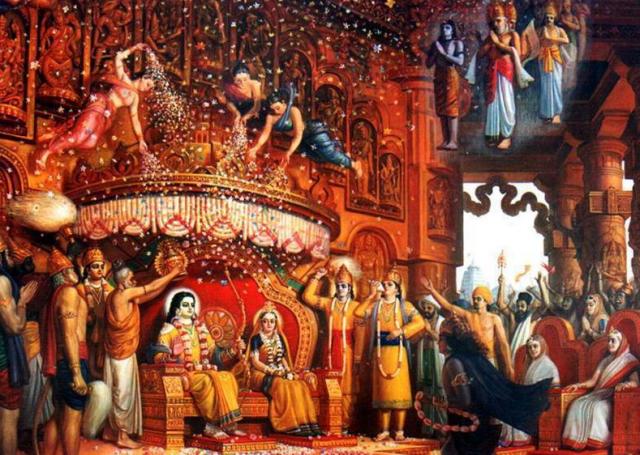Deepavali or Diwali is celebrated on last day of Aswayuja month, which is a newmoon day (Amavasya).
There are many events wrongly connected to this day in puranas and itihasas.
One such event is return of Rama along with Seetha and Lakshmana to Ayodhya.

But, Rig Veda suggests that ancient rishis lived in Arctic region, closer to north pole.
At Poles, Day or Night continues for almost 6 months.
Sun appears on Mesha Sankranthi day (the sun entering the Aries sign of the Zodiac), which today is in Mid-April each year. Sun sets in this region on Thula Sankranthi day (when the sun enters Libra), which today is in mid-October each year. In the movement between these two signs, there is an interval of six months. After the sun sets in Libra, the dark half-year starts.
When Sun enters Vrischika Rasi (Scorpio), which is late October or Early November, it starts getting really dark and Aswayuja Amavasya (New Moon Night) is chosen by ancient people to start lighting their lamps from this day.
These lights originally were not just for one night.
As they would be in darkness for a 6 months period, the lamp that was lit as Nithyajyothi (the perennial light) or Akhanda-Jyothi (nonstop light).
Even today few temples in Kashmir, Uttarakhand like Badrinath, Kedarnath lit Akhanda-Jyothi before their closure in winter and when they reopen in early summer, the oil lamp remains lit.

At North Pole, the year is divided as : 194 days sun (daytime) ; 76 days darkness; 47 days dawn; 48 twilight.
One of the striking events at Pole is : The sun rises in the South.
In the Rig Veda 24-10 the constellation of Ursa Major (Rikshah) is described as being placed “high” (uchhâh), and, as this can refer only to the altitude of the constellation. It must then have been over the head of the observer, which is possible only in the Circum-Polar regions.
अमी य रक्षा निहितास उच्चा नक्तं दद्र्श्रे कुह चिद दिवेयुः |
अदब्धानि वरुणस्य वरतानि विचाकशच्चन्द्रमा नक्तमेति || (Rig Veda 1.24-10)
Translation : Whither by day depart the constellations that shine at night, set high in heaven above us?
Varuṇa’s holy laws remain unweakened, and through the night the Moon moves on in splendor
This proves that the rishi who composed this was living at North Pole during that time.
The idea that the day and the night of the Gods are each of six months duration each, is widespread in the Indian literature and included even in puranas and Astronomy books like Surya Siddhanta.
Sûrya-Siddhânta, XII, 67, says: — “At Meru, Gods behold the sun after but a single rising during the half of his revolution beginning with Aries.”

Manu Smriti I-67, While describing the divisions of time it says, “A year (human) is a day and a night of the Gods; thus are the two divided, the northern passage of the sun is the day and the southern the night.”
Mahabharata, chapters 163 and 164 of the Vanaparva, Arjuna’s visit to the Mount is described in detail and Vyasa writes, “At Meru the sun and the moon go round from left to right (Pradakshinam) every day and so do all the stars.”
A few verses further, and we find, “The day and the night are together equal to a year to the residents of the place.”
Taittirîya Brâhmana (III, 9, 22, 1), has a passage which clearly says, “That which is a year is but a single day of the Gods.”
अशोच्यग्निः समिधानो अस्मे उपो अद्र्श्रन तमसश्चिदन्ताः |
अचेति केतुरुषसः पुरस्ताच्छ्रिये दिवो दुहितुर्जायमानः || (Rig Veda 7.67-2)
Translation : Brightly hath Agni shone by us enkindled: the limits even of darkness were apparent.
Eastward is seen the Banner of the Morning, the Banner born to give Heaven’s Daughter glory.

Not only men, but Gods, are said to have lived in long darkness. In Rig Veda X, 124-1, Agni is told that he has stayed “too long in the long darkness,”
इमं नो अग्न उप यज्ञमेहि पञ्चयामं तरिव्र्तंसप्ततन्तुम |
असो हव्यवाळ उत नः पुरोगा जयोगेवदीर्घं तम आशयिष्ठाः ||
Translation : COME to this sacrifice of ours, O Agni, threefold, with seven threads and five divisions.
Be our oblation-bearer and preceder: thou hast lain long enough in during darkness.
Rig Veda and Valmiki Ramayana mention about Northern Lights or Aurora Borealis where Valmiki equates the light of ‘Northern Lights or Aurora Borealis‘ to the ‘light that emits from sages who have attained ‘siddhi‘.

Valmiki Ramayana, Yuddha Kanda (124-1) clearly mentions that 14 years forest exile period of Rama ended on 5th day of the bright half of a lunar month.
Here month is not mentioned, but following the previous events in Kishkinda Kanda and Sundara Kanda, it can be concluded that it ended in early Chaitra Maasa (which corresponds to Vasanta Ritu i.e March)
Kishkinda Kanda clearly mentions that after killing Vaali and coronating Sugreeva, Rama and Lakshmana waited for Varsha Ritu (Rainy Season) to be over and only in early Sarad Ritu (Autumn) that Vanaras were sent in different direction to find Seetha.
Vanaras sent in Southern direction in Sarad Ritu (September – October) lose their way and enters in a Big cave, where they meet a lady Swayamprabha.

After coming out of that cave and reaching Ocean, they found that much time was lost and already Vasanta Ritu (Spring season i.e March-Arpil) has arrived.
ते वसंतम् अनुप्राप्तम् प्रतिवेद्य परस्परम् |
नष्ट संदेश काल अर्था निपेतुर् धरणी तले || ४-५३-५
Translation : On discussing among themselves they found that spring season has arrived, and they also found the purpose of timely messaging about Seetha to Sugreeva is lost, thus they plumped down onto the surface of earth.
Hanuman reached Lanka during the Vasanta Ritu (March-April).
Sundara Kanda describes Vasanta ritu starting in Lanka and Asoka Vatika.

If one more month is added for Sri Rama travelling with Vanaras by foot, reaching Lanka, then killing Ravana will be in Vaisakha month (April-May).
Indrajit was killed on Krishna Chaturdasi (29th day) of Phalguna maasa. While consoling Ravana, a minister called Suparshva, spoke the following words Ravana.
अभ्युत्थानं त्वमद्यैव कृष्णपक्षचतुर्दशीम् || ९२-६-६६
कृत्वा निर्याह्यमावास्यां विजयाय बलैर्वृतः |
Translation : Making yourself ready today itself, the fourteenth day of the dark half of this month, you along with the armies, sally forth tomorrow, the moonless day, to victory.
6 days later, Rama starts his journey back to Ayodhya on 5th day of bright half of Chaitra maasa (April).
पूर्णे चतुर्दशे वर्षे पञ्चम्यां लक्ष्मणाग्रजः |
भरद्वाजाश्रमं प्राप्य ववन्दे नियतो मुनिम् || ६-१२४-१
Translation : After completion of fourteen years of his exile and on the fifth day of the bright half of the lunar month of Chaitra, Rama, who was disciplined even now, reaching the hermitage of the sage Bharadwaja, offered his salutation to the sage.
पञ्चमीमद्य रजनीमुषित्वा वचनान्मुनेः |
भरद्वाजाभ्यनुज्ञातं द्रक्ष्यस्यद्यैव राघवम् || ६-१२५-२४
Translation : You can see Rama here itself today, when he has been duly permitted by Bharadwaja the sage, after spending, at the instance of the sage, for a night of the fifth lunar day (of the bright half of the month of Chaitra).
तं गङ्गां पुनरासाद्य वसन्तं मुनिसंनिधौ || ६-१२६-५४
अविघ्नं पुष्ययोगेन श्वो रामं द्रष्टुमर्हसि |
Translation : Reaching the coast-line of Ganga-river again, Rama is staying in the presence of the sage, Bharadwaja. Tomorrow, when the moon will be in conjunction with the asteroid, Pushya you will be able to see Rama, without any obstacle.
So, Rama landed in Nandigrama, where Bharata was worshipping footwear, on a day when Moon was in Pushyami nakshatra.
All these prove that Ravana’s death has nothing to do with Vijaya Dasami and Deepavali has nothing to do with Rama returning to Ayodhya or getting coronated as King.

These traditions of celebrating victory of Good or Evil has been mixed with Ramayana events.
Infact, Bhagavatam mentions that Krishna and Satyabhama killed Narakasura on fourteenth day of the dark half of Aswayuja, which is one day before Deepavali.
So, that day is celebrated as Naraka Chaturadasi and next day when Krishna returned victorious, Lights were lit and Deepavali was celebrated.
Though Vishnu Purana mentions that it was Vishnu who killed Narakasura, but the tithi (lunar day and month) is same.

There are multiple versions of Ramayana composed at later dates, along with Padma Purana.
Adhyatma Ramayana (composed mostly in 13th century CE) mentions crackers like flower rockets being fired when procession was taken out during Rama’s marriage with Seetha.
There is no mention of similar celebrations with crackers when Rama returned to Ayodhya from Lanka in Valmiki Ramayana.
